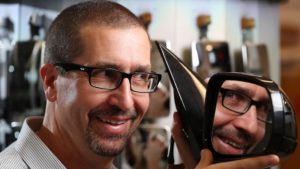An advanced thin-film manufacturing process could see lightweight plastics replacing glass windows and mirrors in a range of passenger vehicles, offering enhanced fuel efficiency and safety.
The mirror can be more easily moulded into dynamic shapes than glass, or curved to provide a wider field-of-view for drivers. It’s also half the weight, less prone to vibration, easier to assemble in its casing, water repellent, and shatterproof in the event of a collision.
The lead inventor of the process is Colin Hall from the Future Industries Institute (FII) at the University of South Australia (UniSA). In collaboration with SMR, an Indian-owned automotive parts manufacturer in Adelaide, Hall’s team has developed a market-first plastic wing-mirror and they’re being exported to the U.S.
Hall has worked with SMR Industries in Adelaide, a unit of Stuttgart, Germany-based SMR Automotive Mirrors Stuttgart GmbH, a global auto accessories manufacturer, to commercialize the mirrors.
Since SMR began selling the mirrors about five years ago, it has exported 1.6 million, mainly to Ford in the United States, where they are sold as optional tow mirrors for F-series trucks.
Hall’s research began when SMR asked him to develop a plastic mirror that was “as good as glass.” It took two years of experimentation to “nail it” and then scale up to manufacturing.
He started with just a chrome layer on top of a clear polycarbonate base and added new layers to achieve specific objectives.
There are five layers of coatings — polysiloxane; silicon dioxide; a chrome alloy to give the mirror finish; another silicon dioxide layer which assists in scratch resistance; then a hydrophobic layer that is water repellent and makes the mirror easier to clean.
The polysiloxane layer is the same product that’s used in auto headlights.
SMR has modified an injection molding machine to maintain optical accuracy in the mirrors.
Having created a plastic that looks like glass, Hall now wants to create one that looks like metal.
Since developing the mirrors, he is now working on other auto accessories in a bid to replace electroplating of common products like grilles, side mirror housings, wheel trims and hubcaps, with plastic layers.
The European Union will ban some electroplated hexavalent chromium finishes in 2017 because of chromium’s adverse health impacts. Hall said that initially gave his research some impetus but auto manufacturers have developed “work arounds” and are “risk averse” with new inventions.
Despite electroplating’s health and environmental disadvantages it is “cheap, established technology.”
“We developed badges for some car companies, but they’ve not been picked up,” Hall said.
He said the plastic mirrors are more expensive than conventional mirrors and the advantage of a lower weight is “not enough to drive car companies” to use them as standard accessories.
Hall said SMR’s Adelaide manufacturing facility can make only relatively small volumes but, if there is sufficient demand, it can scale up within one to two years. “That would be a lovely problem to have,” he said.
At the moment, SMR must balance small volume production while maintaining a competitive price. But Hall thinks automakers might be more interested once they see “many years of in-service performance.”
With Australia phasing out all onshore vehicle manufacturing in 2017, the only potential market for the Aussie invention is overseas.
Hall has just been awarded a 2016 Prime Minister’s prize for new innovators for the shatterproof mirrors. He said the award recognizes the early commercialization of his invention and helps raise the profile of the University of South Australia’s Future Industries Institute, which is beneficial when it seeks funding grants for new research.



